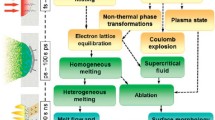Abstract.
Temperature excursions of short duration are useful in exploring the effects of stress on biological systems. Stress will affect the conformation of biological molecules such as proteins, which will lead to an effect on their function. The feasibility of generating such temperature excursions is demonstrated by solving the heat diffusion equation for an aqueous layer on a silicon wafer. The silicon is rapidly heated by a laser pulse and also acts as a heat sink to quench the temperature rise. An oxide layer was used to limit the maximum temperature attained by the sample. We show that exposures above a 50 °C benchmark can be confined to times less than 5 µs.
Similar content being viewed by others
Author information
Authors and Affiliations
Additional information
Electronic Publication
Rights and permissions
About this article
Cite this article
Steel, B.C., Bilek, M.M., McKenzie, D.R. et al. A technique for microsecond heating and cooling of a thin (submicron) biological sample. Eur Biophys J 31, 378–382 (2002). https://doi.org/10.1007/s00249-002-0228-0
Received:
Revised:
Accepted:
Issue Date:
DOI: https://doi.org/10.1007/s00249-002-0228-0




